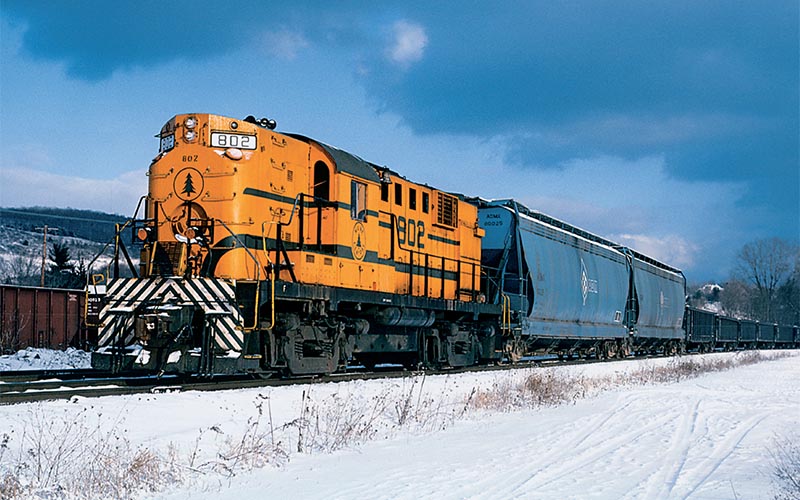
By TRP Staff/Photos as noted
This railroad runs on paper. Yes, if it weren’t for the paper industry, you probably would never have heard of the Maine Central, and the chances that it would have existed during your lifetime would be just about zero. Between finished paper products, chemicals, and raw wood materials, the railroad was kept busy and their bank account got fat. Their emphasis on passenger service dramatically waned by the middle of the 20th Century and they ran their last regular scheduled passenger train in September 1960, long before Amtrak came along. Soon afterwards, the E7’s and the passenger cars were sent packing.
Railfans found the railroad to be a great target for their cameras. The motive power was well-maintained and painted in a very attractive scheme. The scenery was first-rate and the… (ah well, should we say frugal?) management was slow to replace their old structures, so not only do you utilize the quaint New England architecture in the small towns, you also are able to find historic railroad buildings all along the line.
Headquartered in Portland, 90% of the railroad’s nearly one thousand route miles were in Maine, with lesser mileage in New Hampshire, Vermont and Canada. The Portland Terminal Railroad performed switching duties in its namesake city with a solid fleet of dependable Alco switchers. The PT handled heavy interchange traffic with the Boston & Maine and served the Atlantic Ocean port on the city’s peninsula.
 Amazingly, both of Maine Central’s 1956-vintage RS11s, the 801 and 802, lasted into the 1980s and served for Guilford. Late in 1985, Jim Boyd caught this old Alco working under a beautiful winter sky. This locomotive was clearly kept in tip-top shape by the Maine Central shop forces, considering it is nearly 30 years old in this scene. Kodachrome from the collection of Kevin EuDaly
Amazingly, both of Maine Central’s 1956-vintage RS11s, the 801 and 802, lasted into the 1980s and served for Guilford. Late in 1985, Jim Boyd caught this old Alco working under a beautiful winter sky. This locomotive was clearly kept in tip-top shape by the Maine Central shop forces, considering it is nearly 30 years old in this scene. Kodachrome from the collection of Kevin EuDaly
Maine Central’s Portland to Vanceboro main line had many branches that reached various locations in the interior of the state. A few notable additions are the Calais branch from Bangor, the Rockland branch from Brunswick and the second parallel main line called the Back Road from Royal Junction to Waterville that met the Lower Road at each end. Plus, you have the famous Mountain Division from Portland to St. Johnsbury and Beecher Falls that featured the railroad’s only helper division and a dramatic crossing of the White Mountains at Crawford Notch.
As paper companies merged and closed mills, the Maine Central found itself having financial difficulties. In the early 1980s Guilford Transportation Industries amassed a portfolio of New England carriers that included the MEC. Today you will find dark blue diesels marked “Pan Am” where green and gold locomotives wearing pine tree logos once ran. For a carrier tucked away in the corner of the country and hauling trains through sparsely populated areas, the Maine Central has a huge legion of fans and when you see the photos presented here, you’ll understand why.
 Maine Central Alco S4s No. 311 and No. 313 are in charge of the Old Town job at Bangor, Maine, in 1980. This train alone was worth a long drive and braving the tough winter elements of New England to capture on film. Notice that the entire train consists of tanks and woodchip cars courtesy of the large Georgia-Pacific paper mill located on the bank of the Penobscot River. Kodachrome by Dave Augsburger
Maine Central Alco S4s No. 311 and No. 313 are in charge of the Old Town job at Bangor, Maine, in 1980. This train alone was worth a long drive and braving the tough winter elements of New England to capture on film. Notice that the entire train consists of tanks and woodchip cars courtesy of the large Georgia-Pacific paper mill located on the bank of the Penobscot River. Kodachrome by Dave Augsburger
Read more in the 2016-2 issue of Trains & Railroads of the Past!



